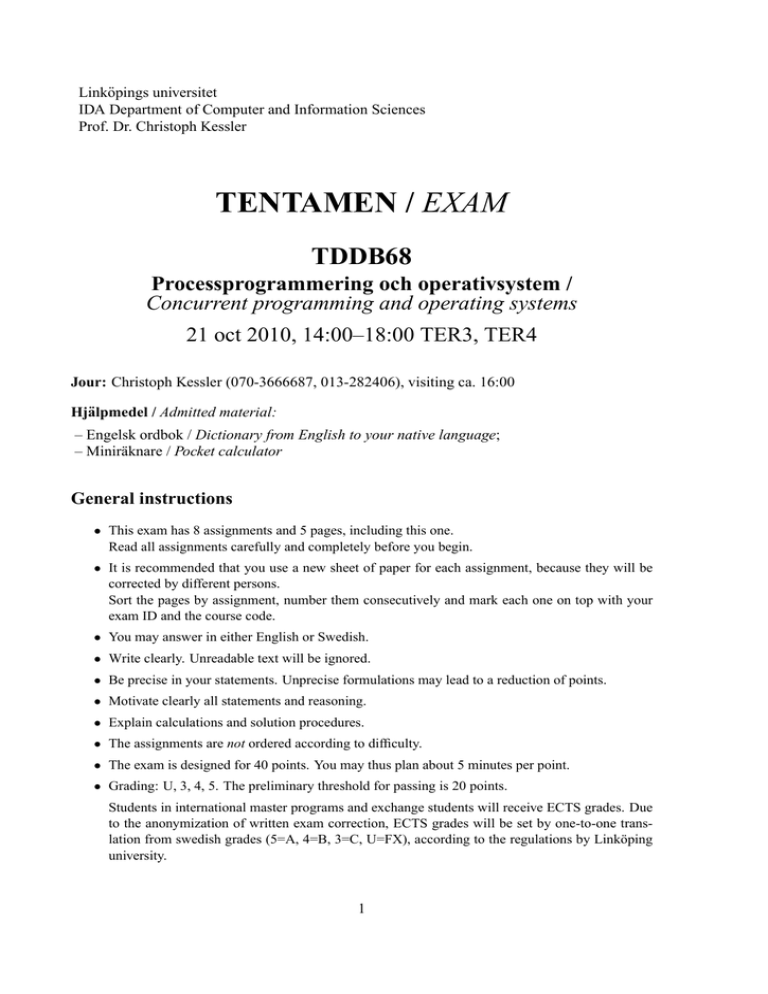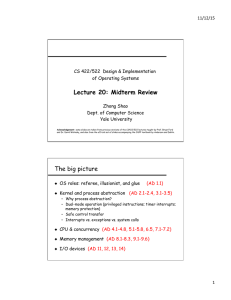Document 13113970
advertisement

Linköpings universitet
IDA Department of Computer and Information Sciences
Prof. Dr. Christoph Kessler
TENTAMEN / EXAM
TDDB68
Processprogrammering och operativsystem /
Concurrent programming and operating systems
21 oct 2010, 14:00–18:00 TER3, TER4
Jour: Christoph Kessler (070-3666687, 013-282406), visiting ca. 16:00
Hjälpmedel / Admitted material:
– Engelsk ordbok / Dictionary from English to your native language;
– Miniräknare / Pocket calculator
General instructions
• This exam has 8 assignments and 5 pages, including this one.
Read all assignments carefully and completely before you begin.
• It is recommended that you use a new sheet of paper for each assignment, because they will be
corrected by different persons.
Sort the pages by assignment, number them consecutively and mark each one on top with your
exam ID and the course code.
• You may answer in either English or Swedish.
• Write clearly. Unreadable text will be ignored.
• Be precise in your statements. Unprecise formulations may lead to a reduction of points.
• Motivate clearly all statements and reasoning.
• Explain calculations and solution procedures.
• The assignments are not ordered according to difficulty.
• The exam is designed for 40 points. You may thus plan about 5 minutes per point.
• Grading: U, 3, 4, 5. The preliminary threshold for passing is 20 points.
Students in international master programs and exchange students will receive ECTS grades. Due
to the anonymization of written exam correction, ECTS grades will be set by one-to-one translation from swedish grades (5=A, 4=B, 3=C, U=FX), according to the regulations by Linköping
university.
1
1. (6 p.) Interrupts, processes and threads
(a) Define the terms process, kernel thread and user thread, and explain the differences
between them. (3p)
(b) Given the following (Unix) C program:
#include <stdio.h>
#include <unistd.h>
int main()
{
fork();
fork();
fork();
printf("Hello\n");
return 0;
}
When executed, how many times will Hello appear on the standard output? Explain your answer! (2p)
(c) The system call API (application programming interface) is a software abstraction
for invoking OS functionality. Name one kind of technical details that it abstracts
from.
Why is such abstraction important for application programming? (1p)
2. (6 p.) Synchronization
Servers can be designed to limit the number of open connections. For example, a server
may wish to have only N socket connections at any point in time. As soon as N connections are made, the server will not accept another incoming connection until an existing
connection is released.
The current number of available connections could be kept track of by a counter in shared
memory, initialized to N :
shared int N_available_connects = N;
Basically, each incoming connection request could create a new thread that would execute
the following function:
connection *void handle_connection_request( void )
{
while (N_available_connects == 0)
;
// wait...
N_available_connects = N_available_connects - 1;
return make_new_connection();
}
2
and upon closing a connection, the thread would call the following function:
void close_connection( connection *c )
{
release_connection(c);
N_available_connects = N_available_connects + 1;
}
(a) Show by an example scenario that, without using additional synchronization, the
above code can lead to a race condition, resulting in undesired behavior. (0.5p)
(b) Give a properly synchronized solution (C/pseudocode), using either test&set or
atomic swap instructions.
Explain why your solution guarantees absence of race conditions.
Explain whether your solution is fair or not, i.e., whether it guarantees that no connection request could be postponed indefinitely. (3p)
(c) Suggest (pseudocode/English) how to extend your solution to avoid busy waiting in
the case where no connections are available. (1p)
(d) Give a solution using a monitor abstraction. Use C or pseudocode notation with
appropriate keywords to identify the monitor components, and explain your code.
(1.5p)
3. (5 p.) CPU Scheduling
Given a single-CPU system and the following set of processes with arrival times (in
milliseconds), expected maximum execution time (ms), and priority (1 is highest, 5 is
lowest priority).
Process
P1
P2
P3
P4
P5
Arrival time
0
1
5
9
10
Execution time
5
7
2
3
1
Priority (as applicable)
4
3
1
5
2
For each of the following scheduling algorithms, create a Gantt chart (time bar diagram,
starting at t = 0) that shows when the processes will execute on the CPU. Where applicable, the time quantum will be 3 ms. Assume that a task will be eligible for scheduling
immediately on arrival. If you need to make further assumptions, state them carefully
and explain your solution. (5p)
(i) FIFO;
(ii) Round-robin;
(iii) Shortest Job First without preemption;
(iv) Priority Scheduling without preemption.
(v) Priority Scheduling with preemption.
3
4. (5 p.) Deadlocks
(a) There are four conditions that must hold for a deadlock to become possible. Name
and describe them briefly. (2p)
(b) You are given a system with 4 types of resources, A, B, C and D. There are 3
instances of A, 5 instances of B, 1 instance of C and 7 instances of D. Currently,
4 processes P1 ...P4 are running, and for each process, the resources currently held
and its total maximum resource need (including the already held ones) for each type
are given as follows:
Process Already held Maximum total need
ABCD
ABCD
P1
0 1 0 1
0 2 0 4
P2
1 0 0 2
2 2 0 3
P3
1 2 1 1
2 2 1 3
P4
0 0 0 1
1 0 1 3
I.e., currently, process P1 holds already one B and one D out of the 2 Bs and 4 Ds
that it eventually may need in the worst case, etc.
(i) Show that the system is currently in a safe state (calculation). (1.5p)
(ii) In the situation given above, Process P1 now asks for one more instance of D,
in addition to the one B and one D it already has. Is it safe to grant the request?
Why or why not? (calculation) (1.5p)
5. (8 p.) Memory management
(a) Explain how paging supports sharing of memory between processes. (1p)
(b) Given a paged memory system with a translation lookaside buffer (TLB). What is
the effective memory access time if the physical memory access time is 90ns, a TLB
lookup takes 10ns and the average TLB hit rate is 90%? Explain your calculation.
(1p)
(c) Paging for large virtual address spaces and small page sizes leads to the largepage-table problem. Explain one technique how this problem can be solved. Be
thorough! (2.5p)
(d) Given a virtual memory system with 4 page frames, how many page faults occur
with the Least-Recently Used replacement strategy when pages are accessed in the
following order:
1, 2, 3, 4, 5, 1, 3, 2, 1, 5, 6, 7, 2, 5.
(Justify your answer. Just guessing the right number is not acceptable.) (1.5p)
(e) What is thrashing in a virtual memory system? How does it occur? And what can
be done about it? (2p)
6. (4.5 p.) File systems
(a) What information is usually contained in a file control block (FCB)? (At least 4
different items are expected) (1p)
4
(b) Where is the FCB contents stored after a file has been opened? (0.5p)
(c) Name and shortly describe a file allocation method that avoids external fragmentation. (1p)
(d) Describe one technique to extend indexed allocation for large files. (1p)
(e) Describe one case where the file system is not an appropriate abstraction for secondary storage, and explain why. (1p)
7. (3 p.) OS Structures and Virtualization
(a) There are two main disadvantages of using strict layering (with more than just very
few layers) for structuring operating systems. Explain one of them thoroughly. (1p)
(b) What does a virtual machine monitor (also known as virtual machine implementation or hypervisor) do?
Draw also a commented figure that shows where the hypervisor is positioned in the
system software stack and with which other system entities it interacts. (2p)
8. (2.5 p.) Protection and Security
(a) How does memory segmentation support protection? (1p)
(b) What is a Trojan Horse attack? Explain the term in general and sketch one example
scenario. (1.5p)
Lab bonus: If you are first-time registered on TDDB68 in autumn 2010 and have passed
(according to webreg) the entire Pintos lab series by 27 october 2010, we will add 4 bonus
points to your result in this exam.
Good luck!
5



